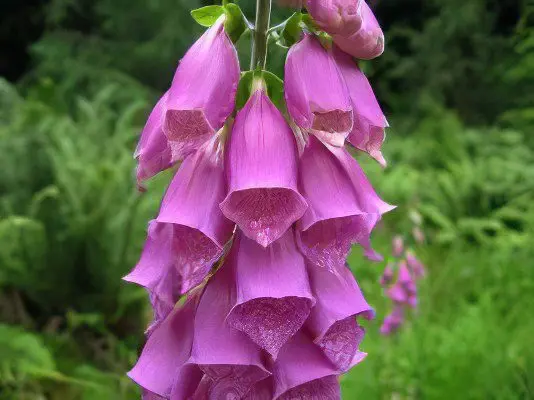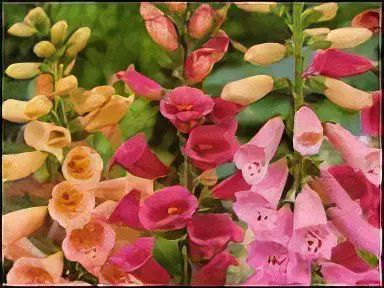Contents
Useful properties of foxglove

Digitalis has been actively used in medicine since the eighteenth century, it was then that official science first revealed its beneficial properties. Many experts noted this medicinal plant as one of the most effective means of the then therapy. Since the middle of the nineteenth century, it has been firmly established in the Russian and then the Soviet pharmaceutical industry. This medicinal flower has several main varieties, the most widely used for obtaining drugs for various effects.
The main medicinal raw materials are the leaves of the plant. They are usually harvested in the first year of cultivation after they have reached the required size. Digitalis leaves contain cardiac glycosides, such as digitoxin, digoxin, lanatosides A, B, C, D, E and some others. Scientists note the high biological activity of digoxin and lanatoside C. It is they who largely determine the usefulness of the flower in the fight against various cardiovascular diseases.
Ancient healers used this medicinal herb to treat chest and abdominal dropsy, epilepsy. In addition, foxglove has long been used in folk medicine as a pain reliever for skin inflammations. However, preparations from it were forbidden to be used to combat inflammation of internal organs, bleeding and severe fever.
The use of foxglove
Medicines from foxglove are one of the most effective medicines for the treatment of chronic heart failure and severe circulatory disorders. Medicine widely uses this plant to eliminate edema resulting from cardiac disorders, it is useful in hypertension and tachycardia. Preparations based on this healing flower are also prescribed for acute infectious diseases, atrial fibrillation, thyrotoxicosis and to normalize the activity of the heart muscle.
Pharmacists use the leaves of large-flowered and purple digitalis to obtain gitoxin and digitoxin in crystalline form, as well as corligide, which is the sum of all glycosides. Traditional medicine uses in the treatment of all ground parts of the plant: stems, flowers, leaves. They are great for preparing decoctions and tinctures that help improve heart function.
Preparations based on foxglove reduce shortness of breath, significantly improve the general well-being of the patient, contribute to the normalization of the pulse. Often, such medications are used for sclerosis of the coronary vessels, mitral valve defects, myocardial dystrophy, and hypertension. Doctors forbid using them for a long time, since some components of the plant tend to accumulate in the body, which can lead to serious consequences.
foxglove flowers
The flowers have a bizarre tubular-bell-shaped shape. Usually they are collected in a one-sided multi-flowered long brush. The color scheme of different plant varieties can vary significantly from each other. Due to its elegant shape and bright color, the flower is often used for decorative purposes. Traditional medicine uses the flowers of this medicinal plant along with the rest of the aerial parts. They are part of many tinctures and decoctions.
foxglove leaves

The leaves are the most used medicinal element of this plant. For medicinal purposes, they are usually harvested in the first year of development and preferably in the afternoon. After collection, the leaves are dried in dryers at a temperature of not more than sixty degrees or in the open air under awnings, laying them out in a thin layer. Harvested raw materials should be stored in a dark and dry place, since when moistened, it may lose its biologically active properties.
The beneficial properties of the leaves are determined by the high content of cardiac glycosides in them, which pass during storage and under the influence of enzymes into other compounds. The leaves also contain organic acids, flavonoids, choline. The leaves are widely used in the preparation of various cardiac preparations.
Quite often, the leaves of the plant are used in traditional medicine recipes, in particular, the powder from them helps with hysteria and some other nervous disorders. In addition, it is actively used for the speedy healing of wounds. It must be remembered that the leaves of the flower are a potent medicine, so you should always adhere to the exact dosage.
How to grow foxglove?
This garden flower is most often propagated by seeds. The best time for this method of cultivation is in the spring, around April-May. Seeds should not be buried deep, but only a little sprinkled with earth. You can speed up the appearance of the first shoots if you pre-soak the seeds for a week. They should be sown in rows with an interval of 45 cm so that adult plants do not die from lack of space. If the seedlings turned out to be too frequent, they must be thinned out, otherwise the flowers of the plant will be small and the honey plants short.
At first, the seedlings develop slowly, so picking (transplanting) is done only after a month and a half at a distance of 5 cm from each other. At the end of May, seedlings are planted in a permanent place. It should be remembered that foxglove loves fertile, loose, permeable soils. If it grows in places with stagnant spring waters, then flowering may not occur.
Digitalis care consists in weeding, loosening the soil and watering in dry weather. A couple of times per season, the plant can be fed with mineral complex fertilizers. Mulching the land with sawdust, which should be done in the fall, also gives good results. The best and most stable specimens are marked in advance in order to collect seeds from them for propagation.
The plant is susceptible to various diseases. If leaf spot can be eliminated with the help of copper-containing fungicidal preparations, then peduncle rot and root rot are incurable. Viral diseases are also very dangerous, which are easy to recognize by twisting the leaves with a tube. In such cases, the plant must be removed immediately.
Digitalis tinctures
Tinctures are among the main dosage forms of this plant. In their preparation, the entire aerial part of the foxglove is used, although the leaves are most often used. Tinctures from this medicinal herb in combination with other medicines are effective in the treatment of heart failure, valvular heart disease and other diseases. They slow down the heart rate, increase the contractile function of the heart muscle, increase the filling of the heart with blood.
With the squeezed juice of a flower, folk healers treated hardening of the breasts in women. Ointments and tinctures of some varieties of this medicinal herb were used externally in the form of washings. They helped well with scrofula or skin diseases.
Types of foxglove

There are several garden forms of the plant, differing among themselves in the height of the trunk, the color of the flowers, the structure of the corollas and their location in the inflorescence. In addition, in different types of flower, the leaves have a different shape, size, character of venation and intensity of pubescence of the leaf blade.
foxglove yellow grows mainly in the center and south-west of Europe. This species is a perennial plant, reaching a height of one meter. It has smooth leaves and stems and bright yellow flowers, which is how it got its name. Yellow foxglove is actively used in landscape design. There are practically no references to its use in traditional medicine.
Digitalis purpurea – the most common and spectacular type of plant. It has a straight cylindrical stem, large and beautiful purple flowers. It reaches a height of up to 120 cm. This species is especially common in the Mediterranean, Southern, Western and Central Europe. It is widely used in folk medicine and pharmacology. In particular, gitoxin and digitoxin are extracted from the leaves.
Decoctions and infusions of this medicinal herb promote effective wound healing and help with hysteria. It is also worth noting the presence of minerals, organic acids, saponins, flavonoids, vitamins and some other useful components in the plant.
foxglove woolly is the most unprepossessing of the representatives of its kind. It has smaller flowers compared to other species. Despite this, it is actively used in medicine. Due to the content of acetyldigitoxin and celanide, preparations are obtained from woolly foxglove that regulate the activity of the heart muscle. The leaves of this plant have the greatest healing power. Traditional medicine uses them to treat heart disease and ascites.
foxglove large-flowered is a perennial herbaceous plant, reaching a height of one meter. Its root is short, the stem is straight. Its leaves reach 20 cm in length and have a light green color. Large-flowered foxglove is one of the five most used varieties of this plant in medicine. On its basis, many cardiological drugs are produced. Often it is used to treat circulatory failure.
The leaves of this medicinal herb contain many useful components: cardiac glycosides, steroid saponins, mineral salts, tannins, phenolcarboxylic acids, iridoids. For medicinal purposes, the leaves are best harvested in late August and early September.
The foxglove is perennial. This species includes a large number of varieties. They are widely used as an effective medicine and an elegant decorative element. Perennial foxgloves have a unique set of components useful to the human body, thanks to which they have been used in folk and official medicine for several centuries. In cultivation, they are very unpretentious, can put up with a lack of sunlight and tolerate frost well.
Contraindications to the use of foxglove
It should be remembered that the substances contained in the foxglove flower tend to accumulate in the body and an excessive concentration of glycosides contained in it can cause poisoning. This plant is very poisonous, so self-medication can lead to poisoning of the body, the symptoms of which are arrhythmia, nausea, diarrhea, blue lips and vomiting. Any digitalis preparations should be taken only on the recommendation of a doctor and always under his supervision.
This medicinal herb is categorically contraindicated in people diagnosed with heart disease, coronary insufficiency, myocardial infarction, infectious diseases and bradycardia. Due to its toxicity, it is forbidden to plant it near children’s institutions.









